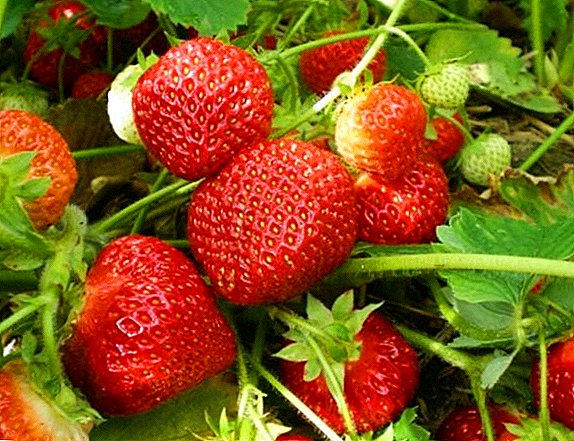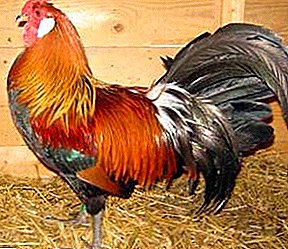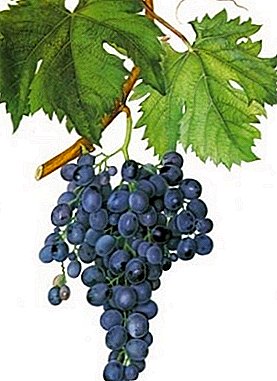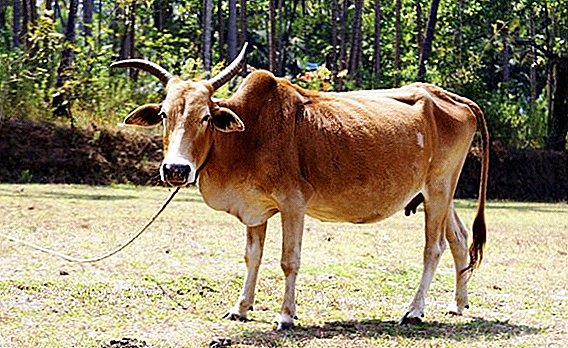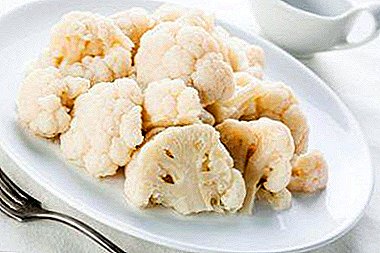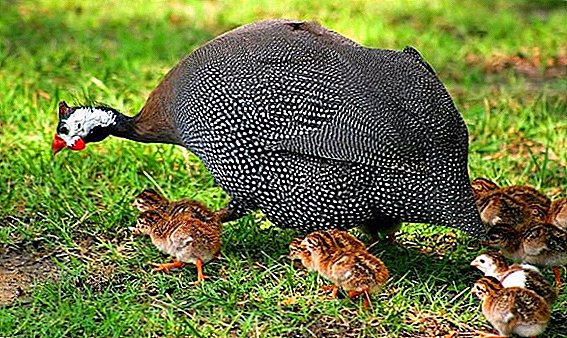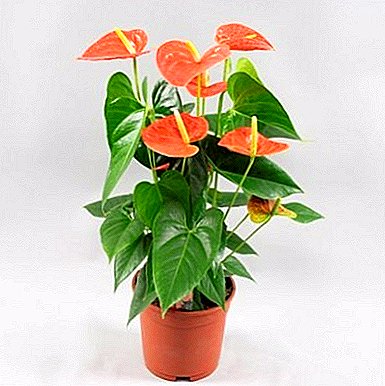
Elegant Anthurium Andre is a plant that attracts the eyes and becomes the highlight of any interior. Noble dark and dense foliage, modest cobs of inflorescences and expressive bright scarlet blankets - all this gives it a unique look.
There are varieties with a different color "sails" - purple, brown, white, black. Needless to say, there is anthurium for every taste.
On top of that, caring for him is not so complicated - a handsome green man gets acclimatiously under indoor conditions.
Description
Anthurium Andre or Andrianum, majestic in Latin Anthurium andreanum, is a member of the Aroid family or Aronnikovye family. His homeland can be considered tropical forests of the mountains of Ecuador and Colombia. The genus Anthurium is very numerous (includes up to 900 species), and its name comes from the Greek words "tail" and "flower". Also, the plant is called "flower-flamingo" or "wax flower".
Originally Anthurium - it is an epiphyte growing on trees and eating by air roots, but adapted to life on earth. There are species that live in rocky crevices.
Anthurium Andre is an evergreen perennial with a short stem and shiny leaves of rich green color and elongated shape. Their length can reach 30 cm and width - 12 cm.. An interesting characteristic feature of the leaf is a clearly delineated heart-shaped base.
Pale yellow anthurium flowers are collected in a neat ear about 10 cm long.
The most spectacular detail of the appearance of this representative flora - prisotsvetny sheet-veil. It is glossy, fairly wide, slightly shriveled or even bubbly and differs in a heart-shaped form and pronounced veins.
Anthurium fruits are round, orange, slightly extending from the small flowers of the cob.
Anthurium Andre enjoys great love among breeders - a huge number of varieties are bred. All of them have different growth rates, flowering duration (from 1 month to a whole year) and the color of the colored leaf - it is white, yellow, pink, orange, red, green, purple, brown, burgundy, almost black and even two-colored.
Lifespan flower with proper care - 3, and sometimes 4 years. Then the plant is rejuvenated.
Anthurium Andrianum (Andre): home care
Anthurium Andre considered the most affordable for growing of all his kindred. However, we should not forget that this is a native of the tropical jungle, where high humidity throughout the year is the habitat of the flower. The same conditions must be strictly observed when the plant is kept indoors.
In addition, it must be remembered that all parts of the exotic representative of the flora are poisonous. When caring for him, it is important to observe all precautions, use rubber gloves and wash hands thoroughly. The green pet must be kept away from children and pets.
The choice of location and temperature
Anthurium Andre prefers a bright light, but it must be positioned so that direct sunlight does not fall on its leaves. For this fit windows of any orientation, except the south. Placing a plant on a window sill, it is very desirable to take care of its shading in the form of a translucent curtain.
"Flower-tail" loves the heat, but favorably applies to the usual summer temperature of our latitudes 22 to 25 ° C. In winter, he feels good at a temperature of from 16 to 18 ° C. In addition, cool for one and a half to two months stimulates budding and flowering.
Watering and moisture

During the warm season, the plant should be watered abundantly, waiting for the top layer of the substrate to dry out - about twice every 7-8 days. With the onset of winter watering is reduced to once a week. At the same time, excess water in the pan must be drained.
Anthurium Andre is very picky about water quality. Even soft, settled water is not good enough for him. It is recommended to boil it or acidify with acetic acid or citric acid.
High humidity from 85 to 95% year-round - the most difficult wish of anthurium. It is necessary to use all possible methods for its implementation. Excellent helps daily spraying of plants in the mornings and evenings. You can also install it on a tray with a wet filler, and next to place containers with water. The cardinal method is a humidifier. The flower will not refuse to wipe the leaves with a damp cloth or sponge.
Anthurium loves regular bathing in the shower.
Rinsing it with a strong jet from several sides makes it possible to additionally moisten air roots and foliage, wash off pests and dust.
Top dressing
During active growth, the "wax flower" is fed with complex fertilizers for flowering crops. once in 14-15 days.
Bloom
Anthurium blooms from early spring to late autumn, especially abundant in summer. Interestingly, after flowering, the veil becomes green and becomes an ordinary leaf. From November to January, the plant is resting and gaining strength. As mentioned above, a cool wintering is very important for tying flower buds.
Soil composition and transplanting

The soil for Andre Anthurium, which is a half-epiphyte and has numerous aerial roots, should be light and have good aeration.
Perfect mix for orchids. But it is still better to prepare the substrate yourself. To do this, take one piece of vermiculite and coarse sand and two pieces of crushed pine bark, peat, coniferous and leafy ground.
The mixture can be further improved with a small amount of coconut fiber and small pieces of charcoal. A moss sphagnum is placed on top of the substrate.
Young anthuriums are transplanted every year, and adults - as far as filling the volume of the pot with roots. New capacity should be taken low and the size of the plant. In too large flowerpot you can not wait for flowering. The bottom of the tank should be provided with large drainage holes and covered with a thick layer of drainage. Do not interfere with extra holes in the walls of the pot.
When transplanting should be very careful with the roots - they are very fragile. It is desirable that the base of the bush elevated above the ground by 5-6 cm. At the same time, aerial roots are wrapped in sphagnum moss.
Transplant after purchase
The newly purchased anthurium is undesirable to immediately replace. The plant and so hard transfers place change, and the change of the substrate - this is an additional stress.
You can only remove it from the pot and carefully, without braking the ground, inspect the roots. If they are healthy, you can return the bush back to the container and place it in "quarantine" - separately from other flowers.
For new conditions, the plant usually gets used in a few weeks. After it adapts, you can replant the "new settlers" in a fresh substrate. It is desirable to wash the soil from the roots of transport.
If a new "green friend" is acquired in a deplorable state, too moist and with rotting roots, immediate transplanting is required. Old earth must be washed from the roots, and diseased roots must be removed.
Breeding

- Anthurium can be propagated in various ways, such as:
- Cuttings. The top of the stem is cut and rooted in a separate pot with peat or earthen mixture. It is important not to overmoisten the soil, otherwise successful rooting will not occur.
- Rhizome division. During transplantation, a rather large copy is divided into several parts. You will need a sharp sterile knife and carbon powder (in order to powder the cut). It is important that for each individual part had enough roots and a few stems.
- Leaf. You can plant in the substrate a piece of the stem with a leaf and aerial root. Rooting occurs very quickly.
- Seeds. To collect the seeds, you first need to pollinate the inflorescence in the first days of flowering, several times having spent on the cob with a brush or cotton wool. It is best to cross-pollinate two or more specimens several times in a couple of days.
Anthurium fruits ripen in 9 months or even a year. Surface planting the seeds extracted from the fruit into the ground and crushing them to the ground, it is necessary to create the best conditions for germination: the temperature is about 25 ° C, light and fresh air.
As it grows, 3 picks are made in small containers, the last one - into a full pot. Shoots appear after a couple of months. Flowering is expected only in 3-4 years.
- Side shoots. Carefully separated and planted in separate containers young bushes will delight you with flowering somewhere in a year.
The tip of the extended stem. You can rejuvenate an old plant that has lost its lower leaves by cutting off its top along with two or three air roots and planting it as described above. It is desirable for some time to give the flower a hothouse, often sprinkling it.Great news - the old plant, left without a top, does not need to throw out. Pretty soon after the separation of his "top" on it wake up one or even several kidneys. Subsequently, they grow into young plants.
After the appearance of their own roots, they should be carefully separated from the old stem and planted in new small containers. Within six months, the young will acquire the attractive appearance of adult anthuriums.
Diseases and pests

- Leaves curled - too much light.
- Black specks on flowers - ingress of water droplets.
- Rotting stalks, fungal infection or dark spots on the leaves - excess water.
- Leaves dry and thin - dry air.
- Leaves shallow and no flowering - little light or fertilizer.
Fans of Anthurium Andre may face the following problems:
- The flower can attack:
- Aphid
- Spider mite
- Root nematode
- Mealybug
To cope with annoying insects will help folk remedies or insecticides. The first measure in case of suspicion of infection is bathing in the shower with soap.
As we see Anthurium Andre is the perfect green pet for lovers of bright, catchy, but at the same time elegant plants. Give him a little attention - and the magnificent flower will settle in your house for a long time.
A photo
Next you will see a photo of Andre Anthurium:






